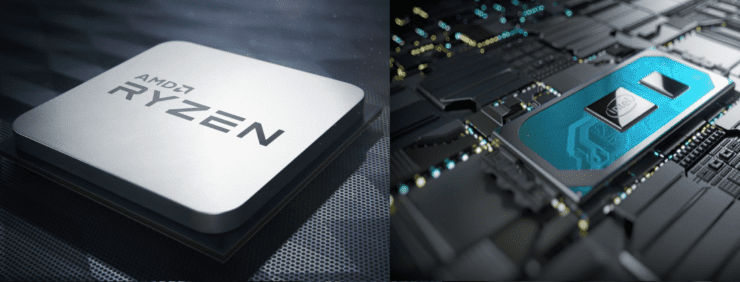
Intel has released a set of new benchmarks as part of its ‘Real World Performance’ testing methodology which compares its 10th Gen Comet Lake-H lineup against AMD’s Ryzen 4000 processors codenamed Renoir.
Intel’s Latest ‘Real World Performance’ Benchmarks Compared 10th Gen CPUs Against AMD’s Ryzen 4000 Renoir APUs, Claims Up To 37% Faster Gaming Performance
The Intel Real World Performance benchmarks have been marked with controversy ever since the blue team started using them. We have seen examples of Intel using different configurations when testing their own and competing chips, giving their own lineup an unfair advantage. We have also seen misleading slides where AMD CPUs were shown as one tier below the Intel CPUs based on its own performance metrics which consist of benchmarks purely optimized for their own processors or single-core workloads.
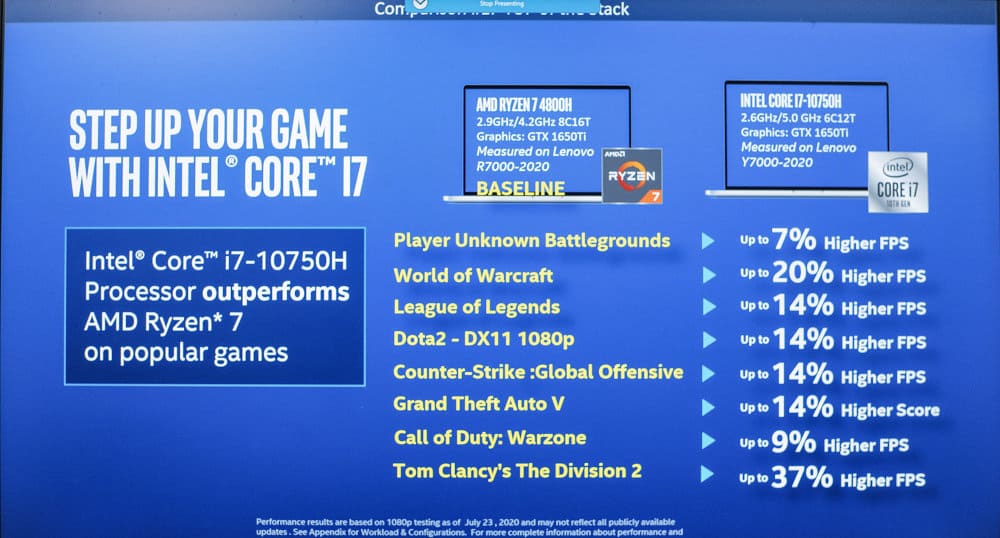
In the latest set of benchmarks published by Benchlife, Intel is shown comparing its 10th Gen Core i7-10750H (Comet Lake-H) CPU to the AMD Ryzen 7 4800H (Renoir-H) APU. The Intel Core i7-10750 features 8 cores and 16 threads on a 14nm process node which clock in at 2.60 GHz base and 5.00 GHz boost clocks with TDP configured at 45W (PL1). The AMD Ryzen 7 4800H, on the other hand, is an 8 core and 16 thread APU on a 7nm process node which clocks in at 2.9 GHz base and 4.2 GHz boost.
One thing that should be mentioned here is that when comparing TDPs, Intel always sets its figures at the base clock. The 45W TDP for the Core i7-10750H is derived at 2.60 GHz while the PL2 rating is derived at the highest boost frequency. For 5.00 GHz, the Core i7-10750H has a PL2 rating of 80W which is almost twice its PL1 TDP. The AMD Ryzen 7 4800H maintains its frequencies within the 45 Watt TDP headroom.
Intel Core i7-10750H vs AMD Ryzen 7 4800H 8 Core Laptop CPUs Benchmarked in Real-World Performance Tests
Coming to the benchmarks, Intel used similar laptop configurations for both CPUs. The laptops used were the Lenovo R7000-2020 (AMD) and Lenovo Y7000-2020 (Intel). Both models feature an NVIDIA GeForce GTX 1650 Ti discrete graphics chip, 16 GB of DDR4 (Dual-Channel) memory, a 512 GB SSD, 1080P HD display and were running on the same OS version (Windows 10 Home V1909 18363.836). The only difference was the memory spec itself which was configured at 2933 MHz for the Intel platform and 3200 MHz for the AMD platform.
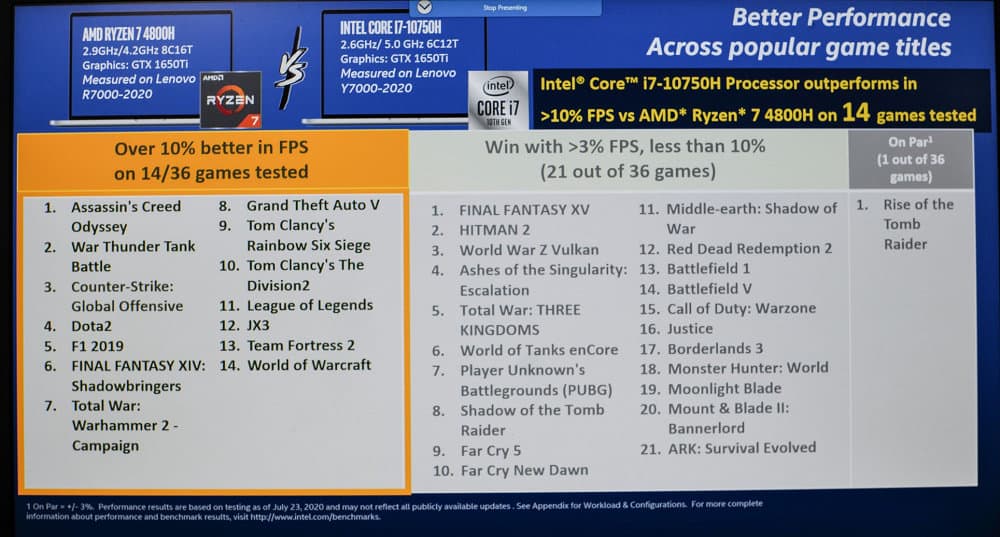
Following are the specifics of the configurations that were tested:
Lenovo Y7000-2020
Intel® Core™ i7-10750H Processor (2.6 GHz base up to 5.0 GHz, 6C/12T, 45 W TDP) measured on Lenovo Y7000-2020, 16GB DRAM (2 x 8 GB DDR4 2933MHz), 512G SSD, 1920 x 1080 display, Nvidia GeForce GTX 1650Ti 4GB, OS: Microsoft Windows 10 Home V1909 18363.836, Battery 60WHr
Lenovo R7000-2020
AMD Ryzen 7 4800H Processor (2.9 GHz base up to 4.2 GHz, 16T/8C, 35 W TDP) measured on Lenovo R7000-2020, 16GB DRAM (2 x 8 GB DDR4 3200MHz), 512G SSD, 1920 x 1080 display, Nvidia GeForce GTX 1650Ti 4GB, OS: Microsoft Windows 10 Home V1909 18363.836, Battery 60WHr
via Benchlife
A total of 36 games were tested at their default settings. In 14 games, the Intel Core i7-10750H got more than 10% higher FPS on average. Tom Clancy’s Division 2 saw the biggest jump in FPS with a 37% gain in performance. Intel claims that its CPU scored better gaming performance than AMD’s Ryzen 4000 Renoir APUs in several popular eSports titles such as PUBG, World of Warcraft, Leauge of Legends, Dota 2, CSGO, GTA V and Call of Duty Warzone.
In 21 gaming titles, the Intel CPU got more than 3% better performance on average than the AMD Renoir APU while the performance was on par with the Renoir APU in a single game (Rise of The Tomb Raider). Following is the description of all the gaming titles that were tested:
Games with performance differences of more than 10% are as follows:
Assassin’s Creed® Odyssey、Counter-Strike:Global Offensive、Dota 2、F1® 2019、FINAL FANTASY XIV: Shadowbringers、Grand Theft Auto V、JX3、League of Legends、Team Fortress 2、Tom Clancy’s Rainbow Six® Siege、Tom Clancy’s The Division 2、Total War: Warhammer 2-Campaign、War Thunder Tank Battle、World of Warcraft
Games with performance differences of more than 3% but less than 10% are as follows:
ARK: Survival Evolved、Ashes of the Singularity: Escalation、Battlefield™ 1、Battlefield™ V、Borderlands 3、Call of Duty®: Warzone、Far Cry® 5、Far Cry® New Dawn、FINAL FANTASY XV、HITMAN™ 2、Justice、Middle-earth™: Shadow of War™、Monster Hunter: World、Moonlight Blade、Mount & Blade II: Bannerlord、PLAYER UNKNOWN’S BATTLEGROUNDS (PUBG)、Red Dead Redemption 2、Shadow of the Tomb Raider、Total War: THREE KINGDOMS、World of Tanks enCore、World War Z Vulkan
Games with the same performance are as follows:
Rise of the Tomb Raider(On Par = +/- 3%.)
via Benchlife
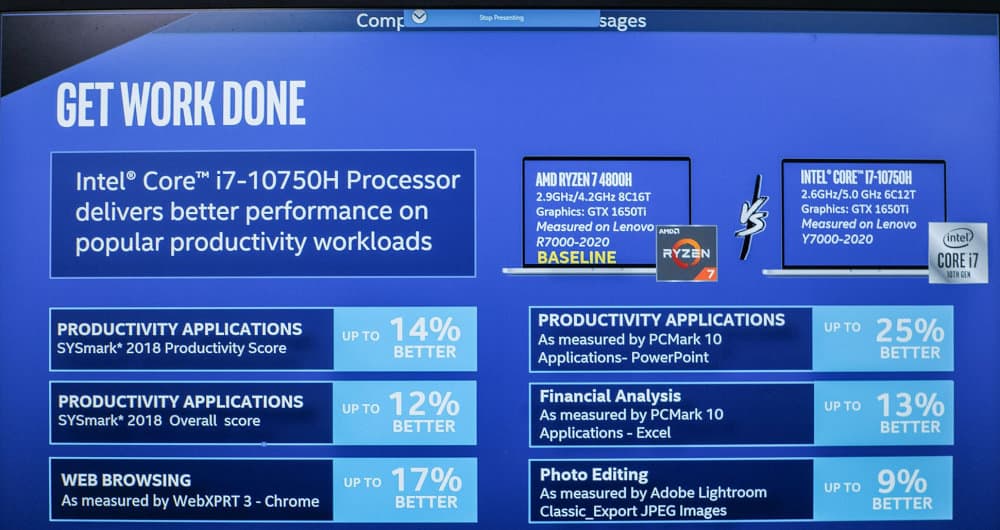
With the gaming benchmarks out of the way, Intel also focuses on the general performance of its CPUs versus AMD’s offerings. The same two CPUs were tested and Intel claims up to 25% better performance in productivity workloads. Intel uses Powerpoint, Excel, Chrome, and a range of other popular benchmarks to test the performance metrics but at the same time, leaves out the multi-threading intensive benchmarks out of its testing suite which is a segment where AMD dominates.
It’s also surprising that Intel is still relying on benchmarks to showcase the potential of its 10th Gen CPUs whereas its CEO stated that the industry should stop focusing on benchmarks. A few months back, an internal Intel memo leaked out revealing that they have been assessing AMD’s progress with their Ryzen, Ryzen Threadripper, and EPYC processors, going as far as to call them a huge risk for their own CPU lineups in the coming years. Meanwhile, AMD is clawing away CPU share from Intel in all segments include servers, desktops, and notebook PCs.

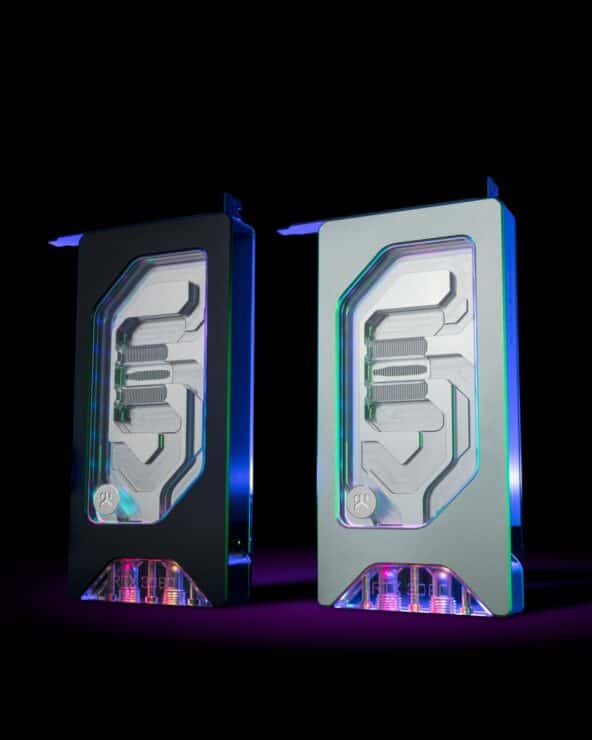


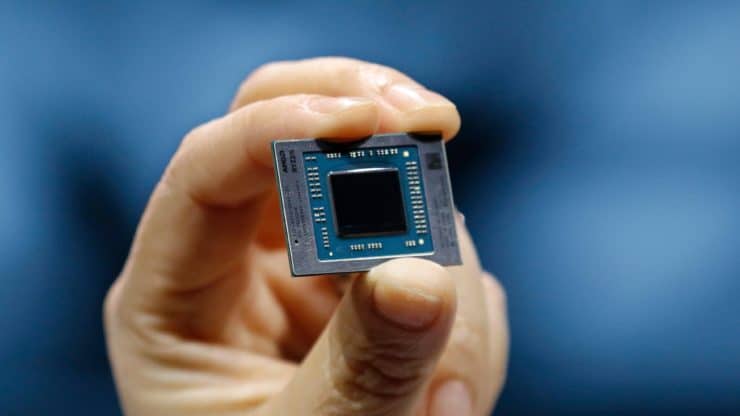
More Stories
EKWB Unveils The Quantum Vector FE RTX 3080 D-RGB – Special Edition Blocks For GeForce RTX 3080 FE Graphics Card
AMD Ryzen 7 5800H 8 Core & 16 Thread Cezanne ‘Zen 3’ High-Performance CPU Shows Up, Early ES Chip With 3.2 GHz Clocks
AMD Ryzen 9 5950X 16 Core Flagship CPU Benchmarked Again, Crushes Intel’s Top Core i9-10980XE 18 Core HEDT Chip